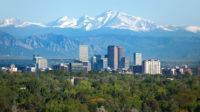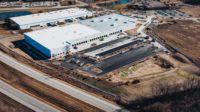COLD STORAGE
Hot Cities for Cold Storage: Dallas-Fort Worth

Image courtesy of earleliason | iStock | Getty Images Plus
They say everything’s bigger in Texas and the demand for cold storage is no different.
The 11 county Dallas-Fort Worth metro area is among the fastest growing in the U.S., and was among the first to rebound in construction starts after the pandemic. While building new homes and apartments lead the way, there is plenty of activity in the cold storage and logistics sectors.
DFW is centrally located among the four major employment centers in North America—New York, Los Angeles, Mexico City and Toronto—and offers distributors access to 79 U.S. markets and 93% of the population within a 48-hour delivery window.
“DFW is a great place to be with the population growth, companies relocating here, and overall access to major markets within Texas and adjacent states,” said Matt McWilliams, president and managing partner of Cold Creek Solutions, which partnered with ARCO National Construction to design and build a 374,560-square-foot cold storage facility in Denton, north of the Dallas-Fort Worth area.
The Cold Creek Solutions facility will have a clear height of 45 feet for the warehouse and 28 feet for the cold dock, allowing for more than 60,000 pallet positions; multiple tenant suites with convertible temperature functionality and 53 refrigerated loading positions. Under construction on roughly 23 acres just northwest of Interstate 35, the project will be only the 15th cold storage facility constructed in the last 20 years in Texas, and one of the latest in the Dallas-Fort Worth area.

“We are developers who focus on demand-driven solutions,” McWilliams said. While our developments may not have a tenant in tow when we come out of the ground, we are hyper focused on developing assets where the cold demand exists, as evidenced by our asset in Denton, Texas. We quickly filled up half of the building shortly after announcing the project.”
Out of the top 10 cold storage markets by capacity, the state of Texas is the most underserved state with the lowest capacity per capita of the subset, according to research by JLL Capital Markets, a professional services firm specializing in real estate and investment management that is marketing the Cold Creek Solutions facility.
The explosion of e-commerce adoption and the rise of online grocery demand during the pandemic has increased the need for cold storage space. Coupled with the age of the majority of cold storage product in the market and lack of available supply, the demand for new construction is stronger than ever.
Two major facilities were completed in the Dallas area last year alone.
Cold Summit Development opened a 343,000-square-foot multi-tenant cold storage facility known as Cold Summit Dallas. The $60 million project is located 12 miles from downtown Dallas and features customizable suite sizes and 50-foot clear heights.
And the largest cold storage facility in the market opened last year in Burleson, Texas, at the Highpoint Business Park.
Yukon Venture Partners, LLC, of Austin, Texas, and Saxum Real Estate, Summit, New Jersey, partnered to develop a 403,336-square-foot refrigerated and cold storage distribution center. RLS Premier Refrigerated Warehouse of Fort Worth anchors the project, which was just the second speculative cold storage investment in U.S. history, according to Saxum.
With a 45-acre site, the development still has room to grow: an additional 300,000 square feet of space could eventually be added, based on tenant demand, the company said.
Entering the Dallas-Fort Worth market is a “critical step” in South Dakota-based Vertical Cold Storage’s strategy, which includes both acquisitions and greenfield development, said company President Curt Mastbergen.
The developer and operator of temperature-controlled distribution centers earlier this year purchased Lone Star Cold Storage of Richardson, Texas, its first location in the DFW area.
“The biggest DFW market benefit is the ability to ship to more than two-thirds of the country's population within a two day’s delivery. In acquiring Lone Star’s Richardson business, Vertical Cold Storage now provides access to those major population centers and because we’re outside of the high traffic areas of DFW, it is much easier to serve customers throughout the region,” Mastbergen said.

The 227,331-square-foot Richardson warehouse has 5,645,661 cubic feet of storage space, 17,982 pallet positions and 40 dock doors. The facility is partitioned into seven rooms allowing for multiple temperature needs from -20 to 45 degrees using an ammonia refrigeration system. Services include blast freezing, case picking, cross dock and EDI capabilities, with kitting support available.
The region added more than 1.2 million residents over the last decade, growing its population by 20 percent since 2010, according to 2021 U.S. Census data. Dallas-Fort Worth remains the fourth largest market statistical area (MSA) in the country behind New York, Los Angeles, and Chicago.
“All those people need to eat, so there’s a rapidly-growing need for cold storage services,” Mastbergen said. “The industry faces a labor shortage which has been accentuated by COVID. By assembling a network of cold storage facilities that feature extensive automation, we can make the global food supply chain more consistent and pandemic-proof. This means keeping food available for families at the grocery store or wherever they shop, even during crisis, in every market served.”
Looking for a reprint of this article?
From high-res PDFs to custom plaques, order your copy today!






